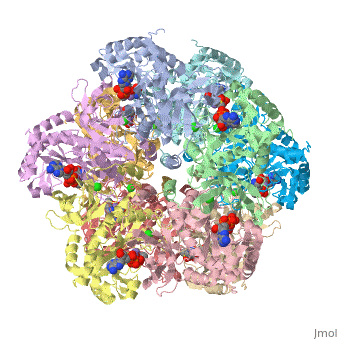User:Uzoma Anele
From Proteopedia
| Line 9: | Line 9: | ||
<scene name='User:Uzoma_Anele/Exercise_1/2'>Backbone Trace with Ligand</scene> | <scene name='User:Uzoma_Anele/Exercise_1/2'>Backbone Trace with Ligand</scene> | ||
| - | <applet load=' | + | <applet load='2qc8' size='300' frame='true' align='right' caption='Human Glutamine Synthetase' /> |
| Line 35: | Line 35: | ||
Helical thongs provide a significant amount of intersubunit stabilization to the quaternary structure of glutamine synthetase by binding together subunits from the two layers. A typical <scene name='User:Uzoma_Anele/Helical_thong_2/1'>helical thong</scene> is composed of a nonpolar carboxyl terminus that inserts into a hydrophobic compartment created by two adjoining subunits on the opposite, corresponding layer. Thirty-seven of the 77 residues of which the helical thong and hydrophobic pocket consist, are apolar and involved in the direct contact between the helical thong and pocket. These residues contain an atypical abundance of proline and valine, 16% and 10%, respectively. This unusual amount may serve to enhance its rigidity and cohesion. <ref name="review">Eisenberg, D., et.al., Structure-function relationships of glutamine synthetases, Biochim Biophys Acta 2000: 1477, 122-145.</ref><ref name="struct">Yamashita, M. M., ''et.al.,'' Refined Atolnic Model of Glutamine Synthetase at 3.5 A Resolution, J Biol Chem 1989 264: 17681-17690.</ref> | Helical thongs provide a significant amount of intersubunit stabilization to the quaternary structure of glutamine synthetase by binding together subunits from the two layers. A typical <scene name='User:Uzoma_Anele/Helical_thong_2/1'>helical thong</scene> is composed of a nonpolar carboxyl terminus that inserts into a hydrophobic compartment created by two adjoining subunits on the opposite, corresponding layer. Thirty-seven of the 77 residues of which the helical thong and hydrophobic pocket consist, are apolar and involved in the direct contact between the helical thong and pocket. These residues contain an atypical abundance of proline and valine, 16% and 10%, respectively. This unusual amount may serve to enhance its rigidity and cohesion. <ref name="review">Eisenberg, D., et.al., Structure-function relationships of glutamine synthetases, Biochim Biophys Acta 2000: 1477, 122-145.</ref><ref name="struct">Yamashita, M. M., ''et.al.,'' Refined Atolnic Model of Glutamine Synthetase at 3.5 A Resolution, J Biol Chem 1989 264: 17681-17690.</ref> | ||
| - | <applet load=' | + | <applet load='2gls' size='300' frame='true' align='center' caption='Helical Thong of Subunit A of Salmonella typhimurium Glutamine Synthetase' /> |
| - | + | ||
=References= | =References= | ||
<references /> | <references /> | ||
Revision as of 20:52, 7 December 2008
Uzoma Anele, Sandeep Pulugurtha Undergraduate students at the University of Maryland, Baltimore County.
Contents |
Exercise 1
|
Exercise 2
Exercise 3
Exercise 4
Outline
Helical thongs provide a significant amount of intersubunit stabilization to the quaternary structure of glutamine synthetase by binding together subunits from the two layers. A typical is composed of a nonpolar carboxyl terminus that inserts into a hydrophobic compartment created by two adjoining subunits on the opposite, corresponding layer. Thirty-seven of the 77 residues of which the helical thong and hydrophobic pocket consist, are apolar and involved in the direct contact between the helical thong and pocket. These residues contain an atypical abundance of proline and valine, 16% and 10%, respectively. This unusual amount may serve to enhance its rigidity and cohesion. [1][2]
|

